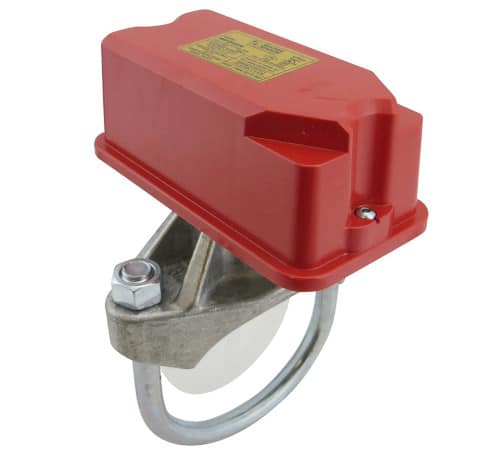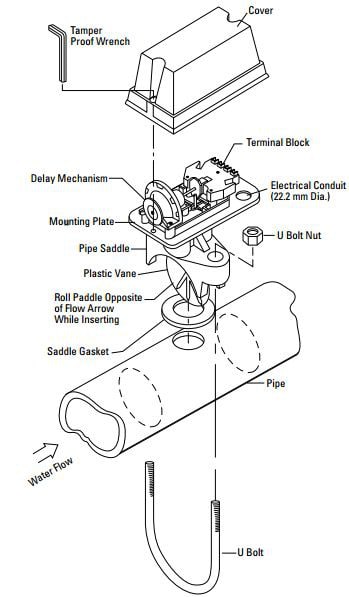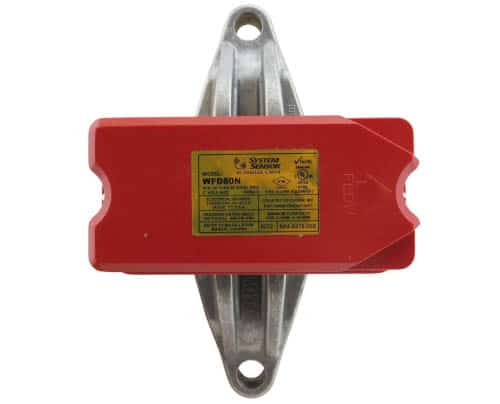A water flow detector, also known as a water flow switch, is an electro-mechanical device designed to send a signal to a local alarm or monitored panel and/or fire department when a continuous flow of water occurs through piping of a fire sprinkler system. This flow signifies an activated fire sprinkler head or a leak in the system.

A vane-type water flow detector includes a plastic vane or paddle that is installed through an opening (or hole) in sizes two-inch through eight-inch schedule 10 or schedule 40 fire sprinkler pipe (see diagram below), either vertically or horizontally. Some water flow detectors can also install in 1 in., 1-1/4 in., 1-1/2 in. and 2 in ferrous and brass threaded tees; 1 in., 1-1/4 in., and 2 in. copper sweat tees; or 1 in. CPVC tees. If water flow greater than 10 gallons per minute is detected, the vane or paddle triggers a switch, sending a signal to an alarm panel and fire alarm bell.
What about false alarms? As you’ve learned thus far, the device relies on accurately reading the flow of water through a pipe, and water flow is not a constant. Surges in water pressure happen regularly — as an example, ever been in the shower when someone flushes a toilet?
That’s why Safe Signal’s water flow detector has a mechanical delay mechanism. Essentially, this timer, which can be set from 0 to 90 seconds, delays the alarm-triggering mechanism long enough to ensure that the change in water flow is not a one-off incident but rather a constant flow resulting from an activated sprinkler or serious leak. If water flow decreases to four gallons per minute or less, the water flow detector resets.
For optimal performance, water flow detectors should be mounted in an area where there is adequate room to service the device and it will not be damaged by normal nearby activity. Other general installation rules include:
- The flow switch should be mounted six to seven feet above the ground.
- On a horizontal pipe, it should be mounted on the top to avoid rust or particle accumulation from interfering with its operation.
- On a vertical pipe, it should be mounted where there is an upward flow of water.
- Other general rules include mounting the device at least 6 inches from fittings that change the direction of water flow and at least two feet from a drain or valve.
The primary electrical components of a flow switch can be replaced without draining the fire sprinkler system. If a device is showing signs of wear and tear, is leaking, or is otherwise non-functional, it should be replaced by a qualified fire protection contractor immediately.
At QRFS, we offer Safe Signal vane-type water flow detectors in sizes ranging from 1″ to 8″. Combined with our superior customer service and extremely fast shipping, you won’t need to look anywhere else when you’re in the market for a fire protection flow switch. And as always, they are UL/FM approved and come standard with a 3-year manufacturer’s warranty.
Browse All QRFS Safe Signal Waterflow Detectors
This blog was originally posted by Jason Hugo at blog.qrfs.com on February 26, 2013, and updated on April 22, 2022. If you like what you’ve read, check us out on Facebook or Twitter.




Is there any reason not to mount a flow switch on a vertical run just upstream from the fire pump? It is mounted approximately 5 to 6 ft. vertically from the 90 degree fitting transitioning from horizontal to vertical coming away from the fire pump. This is a 6 inch line and the flow switch is set at a 90 second delay but we continue to get false flow alarms? There is a jockey pump for the fire pump as well.
Thank you!
Rex — thanks for reaching out. For code questions like this, we recommend submitting your question through QRFS Ask A Pro. Click the link to submit your question with some information about your building or system, and a fire protection professional will provide a detailed answer based on standards and codes. Our pros include AHJs, contractors, engineers, and code experts with 150+ years of combined experience!
Informative article on flow switches!! We can also use flow switches in other applications like Air supply systems and Duct type heating. Can flow switch is compulsory to mounted on six to seven feet above the ground?
Naman — thanks for reaching out. For tech/code questions like this, we recommend submitting your question through QRFS Ask Fire A Pro. Click the link to submit your question with some information about your building or system, and a fire protection professional will provide a detailed answer based on standards and codes. Our pros include AHJs, contractors, engineers, and code experts with 150+ years of combined experience!
What is the useful life of a flow switch? When should we suggest replacement?
Kieran – there is not necessarily a set useful life of a flow switch; they should be replaced when showing signs of wear and tear, if they are leaking, or if they are otherwise non-functional. Problems should be spotted during regular flow testing.
Genrally we install flow switch near to Valve and not 6 ft
I would love to see an application like this in a smaller setting. A model that would detect constant flow for a set point such as “constant flow for more than 10 minutes “ so we could set them up on our in-line water filtration systems.
If a pipe bursts overnight on our filter, the whole area will end flooded when I come in the next morning. Any ideas on solutions?
Mike – we don’t have much perspective on water filtration systems, but the principles behind preventing pipe bursts are similar: an appropriately designed system (pressure, flow) that is maintained to avoid corrosion or freezing and regularly inspected to spot damage (fire sprinklers are hydrostatically tested every five years or upon system expansion). Best of luck.
Hello All. I am all fired-up now. Well, almost. The AHJ in the city I live in modified the section of NFPA 13D -7.6 which states that homes with NFPA 72 compliant smoke alarm/detectors don’t have to have local flow alarms. They have an ordinance which changed that section to read, “A local waterflow alarm shall be provided on all sprinkler systems.” This makes NFPA 13D the same as NFPA 13, and NFPA 13R in that regard. I think I am the only person here who has a multipurpose/looped system. I see no examples of how a flow device can be put into my system. Any help would be appreciated.
Jack — Unfortunately, if the multipurpose system is feeding the faucets (not a passive purge system connected to the toilet), we don’t see an easy way to do this. Many NFPA committee members push back on local jurisdictions mandating flow alarms in residential systems for this reason and others (among others, smoke alarms are better at notifying occupants of a fire condition.) Essentially, the rule could serve as a ban on multipurpose systems, which are often more affordable or convenient.
We suggest raising this challenge with the AHJ and seeking an exception. While we can’t speak to your local government, NFPA standards provide AHJs with significant discretion about determining what is “acceptable,” safe, and follows the intent of fire protection goals and rules. So, they should grant an exception unless they give you a way to comply.
Thank you for your response. We do have the passive purge system, with one connection to a toilet at one end of the house, and the other at the cold water supply in the master bath shower. What also complicates matters is, we had to also install a booster pump to increase city water supply pressure through a limited 3/4″ water meter & lateral (the city water dept. would not allow 1″, unless we paid to have the lateral upsized to 1″); Definitely out of our price range. If I could get some push back from NFPA Committee Members, I would appreciate it. Our installer is tired of dealing with the FD and so am I.
Jack — We can’t necessarily solicit pushback from specific NFPA members for this specific situation, but we could interview some about their perspectives and perhaps write a blog about it, which would fulfill this purpose. It would be an interesting topic, but it takes some time to put together. If you need to deal with the AHJ and this rule in the interim, the fact that these requirements aren’t in the residential standard (13D) makes their intent pretty clear. The primary goal of the standard is making installing these systems easier (while still being effective) so more of them exist and save more lives. Otherwise, you should directly ask them: how do you want me to comply?
Thank you for your response. Yes, they told me how to comply: “I would recommend contacting an electrician and a fire sprinkler contractor and work with them on installing the required device. Once it is done, please notify me and I will have an Inspector verify the installation.
Only we were told by others who know, that it won’t work on our system. Also, fire sprinkler contractors are not supposed to TOUCH other firms work; as we were told by the AHJ.
Hi, would like to ask something about water flow switch. We are now installing another FDAS Loop in an area, there is an existing WFS and sprinkler system. We would like to install a module for the existing WFS for it to be connected to the new loop. My question is , if we will be connecting/ terminating the wires of new module to the existing wfs, do we need to turn off the system? Is there any effect on the sprinkler system?
K — Unfortunately, your situation is not something we can assess in this format and without knowing more information. Your best bet is to contact a qualified fire protection professional (installer/maintainer) in your area and/or the manufacturer of the devices. Thanks for reading and commenting.
Just had my residential wet system inspected and the waterflow test did not trigger the outside alarm (he used his stopwatch).
I don’t know if the outside alarm is required or not. I think we are under 13D. This is a condo complex with 3 side-by-side attached single-story units per building. We each have our own system. The test person mentioned 13D casually in conversation but that seems to be for 1-2 family.
In any case, if the alarm did not go off, is it more likely the flow switch or the alarm or both? Do they get sold/installed together as a pair? Because its a condo, internal items are homeowner responsibility; outdoor items are association responsibility. (note: don’t ever buy a condo… pita)
The test person said my system is working fine as-is to protect my unit from a fire. Seemed to imply the external alarm is optional. Fwiw, he also mentioned a few other units in the complex also did not have working alarm.
Thank you.